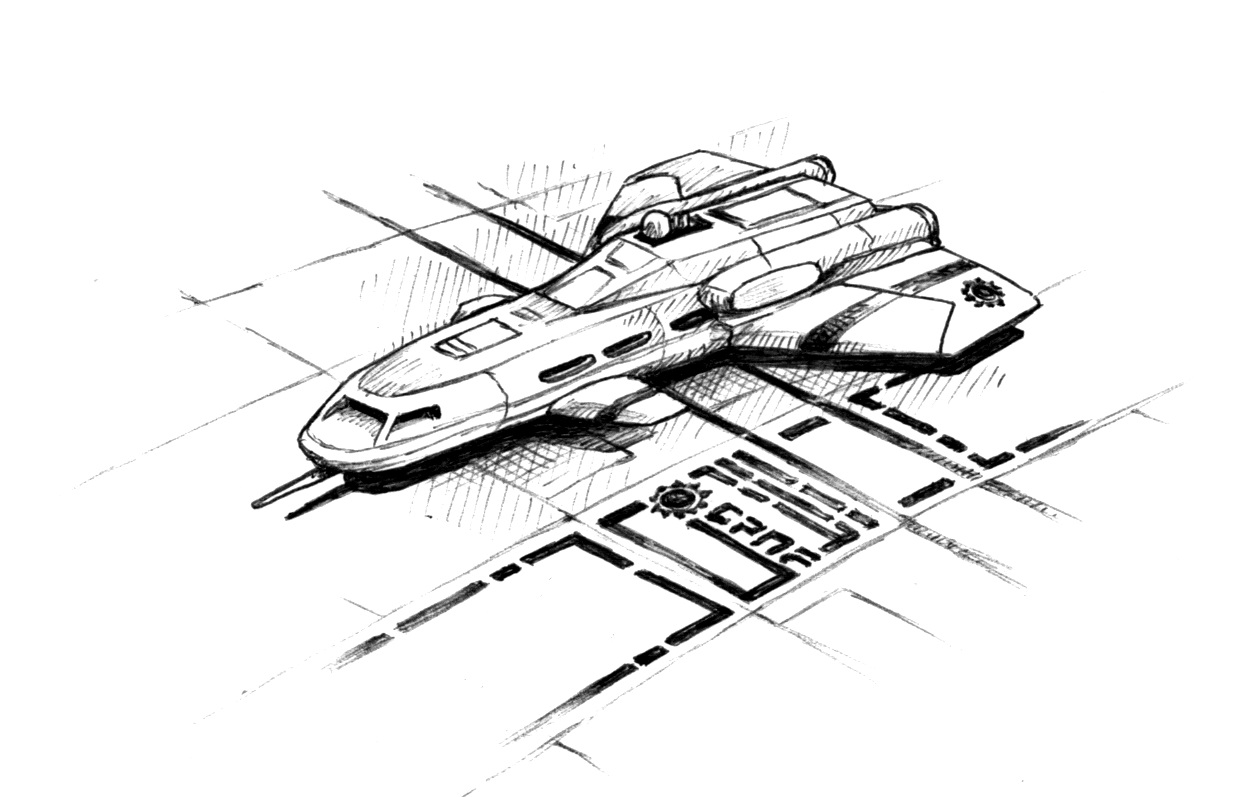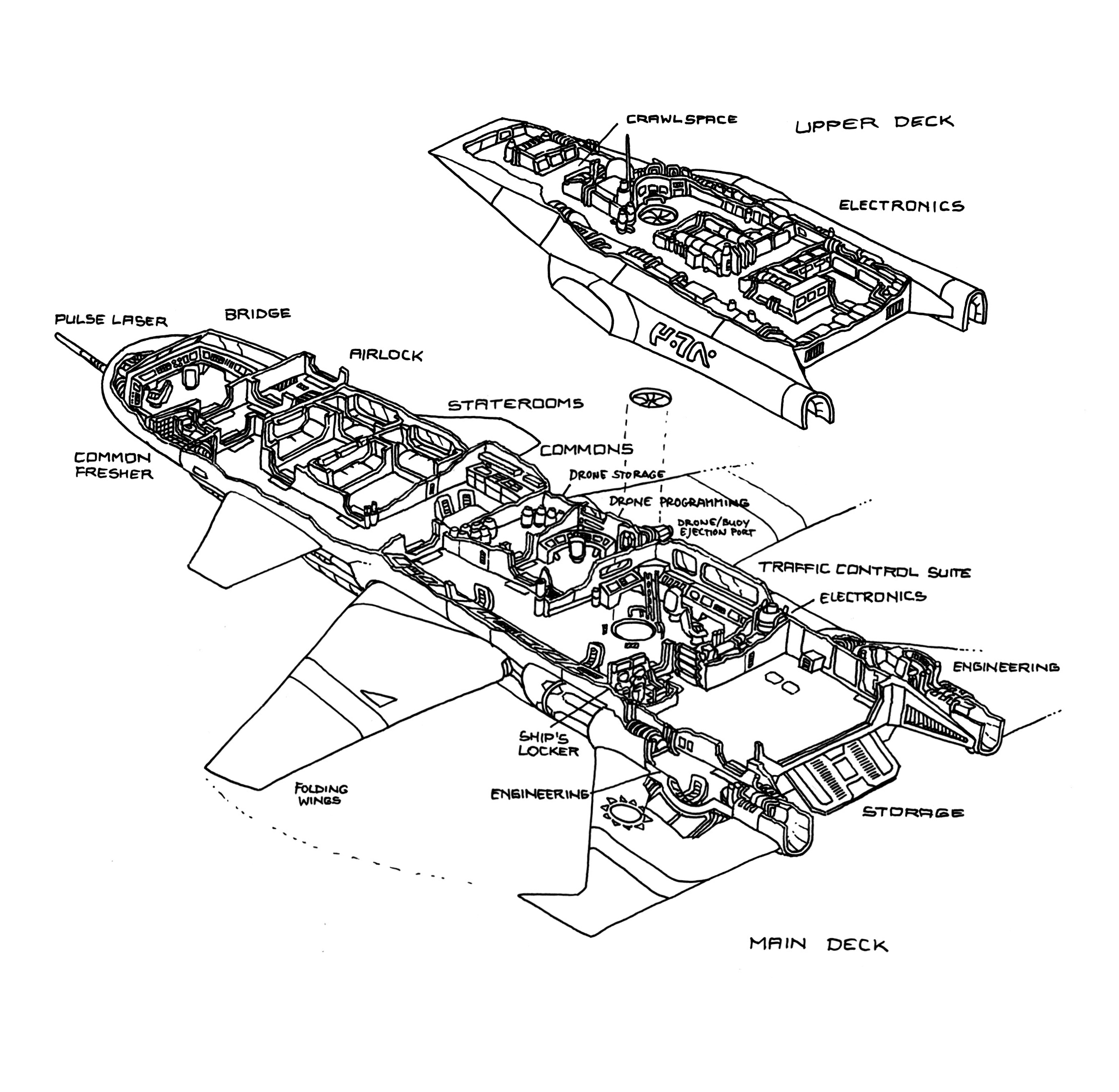SPA Traffic Control Pinnace
This article originally appeared in the May/June 2020 issue.
With increasing trade, traffic control within a system can become a logistical nightmare for the Starport Authority. This is especially the case where the system has several outlying spaceports on different planets or asteroids, or mining stations in the belt. Each port and station has its own traffic control, and co-ordinating schedules takes a lot of effort.
The TC pinnace is one of the possible answers to this problem. It is a flexible vessel that can be employed in a variety of duties all across the system. Pinnaces are used to monitor traffic at the main takeoff points along the jump diameters, accompany visitor ships from different polities to make sure they don´t stray, patrol the main trade lanes from planet to planet, maintain a net of traffic buoys and drones, and guide in damaged ships. They may act as relays for messages and synchronisation data between the different ports’ and stations’ Traffic Control sections. Where pirate activity is suspected, they may even courier this data to its destination in physical form, stored in data bins, to avoid interception.
While nominally armed, usually with a single pulse laser, the TC pinnace is not supposed to fight, neither to attack violators of traffic codes or in self-defense. This duty is handled by system defense boats (which often do a patrol sweep across a wide area to cover as many pinnaces as possible), or by standard pinnaces carrying two 10-dton light fighters each. In a combat situation, the TC pinnace is supposed to flee using its high acceleration, while still keeping track of the offending vessels’ courses, and let Naval vessels deal with the incident.
General Layout
The basic hull of the TC is the standard pinnace with its reconfigurable wing assembly; this model was chosen because of its atmospheric capability, since one of the expected roles of this vessel was to act as a mobile traffic control tower on planets without a starport proper.
Two triple-occupancy staterooms and a commons area/pantry were added. The rest of the pinnace’s cargo space was partitioned off to accommodate a traffic control operations suite and a small computer laboratory to program robotic buoys and traffic drones. Ejecting the drones is done via a specialised port mounted in the hull; recovery is a semi-EVA procedure using the main airlock located just behind the cockpit, and requires an AVERAGE, Pilot, DEX (5 min) check.
The traffic control suite is equipped with a bandwidth-5 computer. Usually this system is equipped with Intellect-1, translation, security and traffic control expert software, and can monitor the drones. In border systems, the computer may also have extensive databases on foreign customs and interspatial law. Lower-TL systems may not have access to computers of this bandwidth, and their pinnaces may provide much less electronic support to their personnel. Instead they rely on the operators’ skill and ability to work under strain.
The aft portion still has a modicum of cargo space, often data drums to deliver to outlying stations, food and toiletries for the duration of the run, and occasionally special courier packages from third parties that Traffic Control may expedite on a favour-for-favour basis. Often, there is still ample free space, and it is not uncommon for crewmembers to come here to be alone, to escape the cramped conditions and avoid the others for a while. The cargo attachment points, by chance or design, are perfectly placed to string up a hammock.
The usual high ceiling of the standard pinnace’s cargo hold has been lowered to a little less than 2.5 meters. The ceiling space now houses the extensive electronics, communications and sensor arrays necessary for Traffic Control duty. If something needs to be fixed, the technician has to “go aloft” via an iris valve. The maintenance crawlspaces on this deck are low (1.2 meters) and narrow; tall persons may find it difficult to turn around. There are so many access panels that it is near impossible to check them all; rumour has it that TC personnel frequently use the space behind the panels to smuggle small packages.
At least one incident has been documented where a traffic operator, when her pinnace was boarded by pirates, cached a storage crystal with sensitive traffic data in a cable shaft and hid out for several days in one of the maintenance spaces. She was eventually discovered (severely radiation-poisoned from being too close to the unshielded active sensor bank) and executed, but the data was still hidden and uncompromised when Naval vessels reclaimed the pinnace.
Typical Duty Shifts
Usually, a shift lasts for three weeks, with two operators on duty, two on standby, and two resting. Service aboard a traffic control pinnace may be the epitome of boredom when monitoring a rather torpid area of space. Managing the traffic outside of “convergence areas” is rather easy – the ships have ample room to maneuver and keep clear of each other. It gets more interesting near stations or heavily occupied standard jump points where many ships converge in a fairly small area. Operators wear out quickly in those areas, and need to be stood down to rest at short intervals. There are situations where this is not always possible, such as when a sudden and unexpected surge in traffic occurs. In such cases, things may get very dangerous if tired-out operators assign the wrong vectors to incoming ships.
| Traffic Control Pinnace TL12 (Mongoose Traveller 2nd Edition) | |||
|---|---|---|---|
| System | Description | Disp (dtons) |
Cost (MCr) |
| Hull | 40 dtons, streamlined;(16 hull pts) | (40) | 2.40 |
| Armour | None (0 hull points) | - | |
| Maneuver Drive | Thrust 5 g (20 power points) | 2 | 4.00 |
| Jump Drive | None | - | |
| Power Plant | Fusion, Power 30 | 2 | 2.00 |
| Fuel Tanks | 4 weeks operation | 1 | |
| Bridge | (8 power points) | 3 | 0.50 |
| Computer | Model 5 | - | 0.03 |
| Sensors | Military Grade (DM +0) (2 power points) | 2 | 4.10 |
| Weapons | Fixed mount, usually a single pulse laser | - | 0.10 |
| Systems | Additional Computer Model 5 Workshop (Drone prog.) Workshop (Traffic Control) |
- 4 10 |
0.03 0.60 1.50 |
| Staterooms | Standard×2 | 8 | 1.00 |
| Cargo space | 8 t (including drones) | 8 | |
| Total Cost | 16.26 | ||
| Monthly Maint Monthly L/S |
Cr1355 Cr8000 |
||
| Crew and (Monthly) Salaries | Pilot/Traffic Control operator Engineer/Traffic Control operator Gunner/Traffic Control operator 3 Traffic Control operators |
|
Cr7500 Cr5500 Cr4000 Cr3000 |
Traffic Control Pinnace Notes
Calculating Crew Salaries
Traffic Control Operator is not defined in any of the rulebooks, so the salary for the role had to be made up. Since the role primarily involves communicating with other ships, it seemed reasonable to consider another role where communication with others is essential: Steward. However, the steward doesn’t have the Sensor Ops skill that it would be reasonable to assume that a Traffic Control Operator would have, so that commands a premium. It seems reasonable that a similar kind of sensor operation was about half of what a Gunner does, so adding half the Gunner’s salary to that of the Steward role gives a total of Cr3000. That may seem high, given that the TCO doesn’t do everything that a Steward does, but consider that a TCO is very much in a similar role to an Air Traffic Controller here/now, and ATCs get premium pay because of the stress in addition to their skills. A TCO in space could reasonably be expected to see the same level of stress, so Cr3000 doesn’t seem out of line (and In Your Traveller Universe, you might even justify more).
There is also no ‘canonical’ method to calculate an appropriate salary for someone in dual roles, such as the Pilot/TCO. Several methods have been proposed; the method chosen here is to calculate ¾ of the sum of the salaries of the two roles, and also to calculate the sum of the higher of the two salaries plus ½ of the lower, and use the higher of the two results. So, a Pilot/TCO gets the higher of [¾ of (Cr6000+Cr3000) , or Cr6750] or [Cr6000+ (½ of Cr3000), or Cr7500]—or Cr7500. Similar calculations were made for the other crewmembers with dual roles.

 Freelance
Traveller
Freelance
Traveller